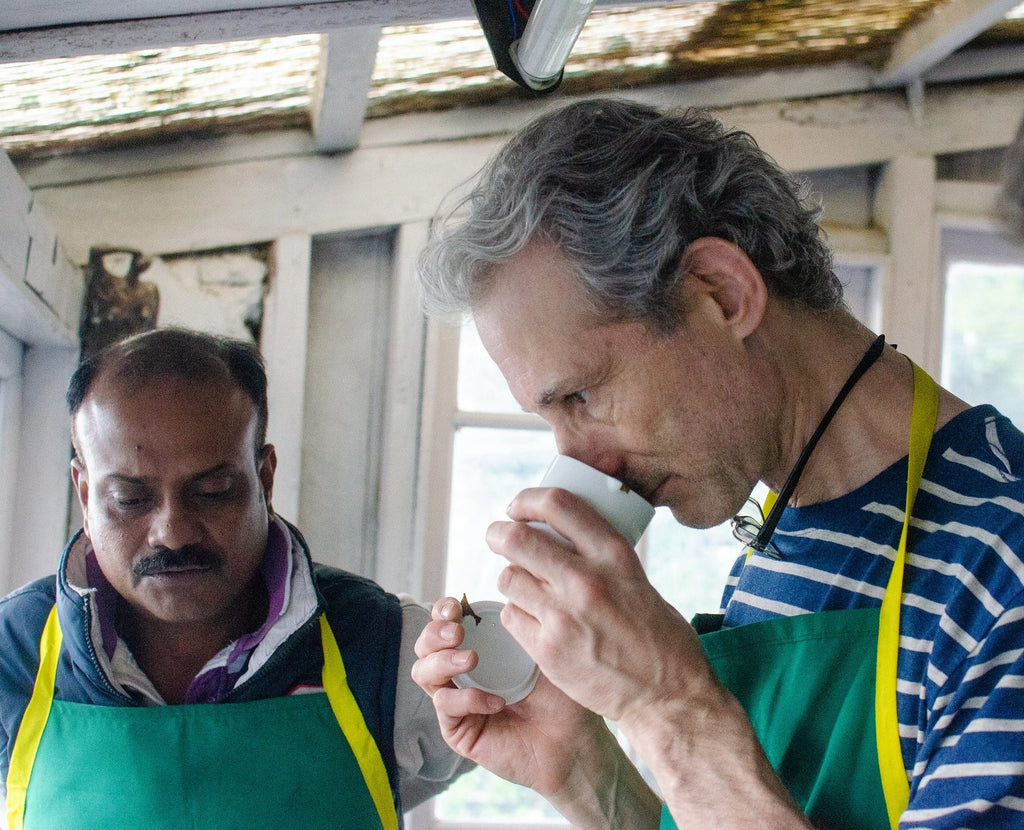How We Source Darjeeling 1st Flush Tea

A new growing season brings another new batch of Darjeeling 1st Flush into our tea room! This delicate, ephemeral taste of spring is one of our specialties at IPOT. Each year we sample dozens of new productions from gardens across Darjeeling's verdant hills to find single origin lots that stand out from the pack. We've selected three for the 2025 season from Jungpana Estate, Gopaldhara Estate, and Giddapahar Estate; you can try them all together in our Ticket to Darjeeling 2025 1st Flush Collection.
People have been making tea in Darjeeling since the 19th century and teas from this region are widely considered the premier brews of the Indian industry. You can learn all about them in our complete guide, but in brief, Darjeeling teas are revered for their unique Himalayan terroir and the high elevation at which they're grown: steep mountain slopes draped in morning fog provide ideal conditions for high quality tea cultivation. That said, a great climate is nothing without a skilled workforce to pluck and process these special leaves. Darjeeling workers keep meticulous standards, especially for the precious first flush, which is the smallest, most prized, and highest value harvest of the year.

There are over 80 registered gardens in Darjeeling. Some make better tea than others. Even within a single garden, however, quality can shift dramatically from one day to the next depending on the fields being plucked, local weather conditions, plant genetics and many other agricultural factors. To find great Darjeeling, you can't just seek out reputable growers—you have to follow your nose and examine the specifics of each lot. Here's what we look for when selecting the best Darjeeling 1st flush teas of the season.
Variety: Darjeeling 1st flush teas can taste floral, vegetal, nutty, creamy, citrus-forward, rootsy and then some. We look for a range of characters that express the diversity of this region. This year's Gopaldhara Estate pick is light and springy with a lemon zest and cucumber vibe, while our Giddapahar Estate lot is richer and more robust.

Plant genetics: Darjeeling tea plants are propagated from seeds (also referred to as "china bush" within the industry) or clonal cuttings. Each seed-grown tea plant is a little different, providing diverse and dynamic flavor to a finished lot. Since clonal teas are genetically identical, they're more predictable to grow and process, which can lead to more precise flavors. Seed-grown and clonal plants are both vital to growing tea in Darjeeling, so we look for each type. The Giddapahar Estate lot is comprised of older seed-grown plants, while the Gopaldhara and Jungpana selections are mixed clonal lots.
Leaf grade and shaping: Every lot of first flush looks a little different. Some might have ample unopened buds that contribute distinctive flavors to the brew, others may be rolled more heavily overall. In recent years, Darjeeling estates have produced more whole-leaf lots reminiscent of Chinese styles that prioritize unbroken leaves. All of these factors contribute to different flavors and aromas to the final cup. If you look closely at our Gopaldhara lot (shown in the center of the photo above), for instance, you'll see it's full of long, silvery buds—from a particular cultivar—while the other two teas showcase slightly smaller leaves.

Organic cultivation: Consumer demand for organic tea has encouraged many Darjeeling estates to convert part or all of their fields to organic standards. Some smaller growers like Giddapahar—one of the last family-owned estates in the region—use organic practices but can't afford the high cost of certification. We look for solid, sustainable farming beyond just a label, with growers using creative solutions to managing pests and disease.
Environmental stewardship: Darjeeling's tea estates were created out of a British colonial plantation system without much regard for the local environment, and 150 years later, the bill for those actions has come due. We work with gardens that invest in their fields for the future. That means planting shade trees to break up monocultures and using ground cover plants to limit soil erosion on steep slopes, among other practices.

Worker investment: The Darjeeling hills are essentially a one-industry town—another legacy of the old colonial system. Young people in the region are increasingly seeking out different work opportunities in larger Indian cities or abroad. If Darjeeling estate managers want to keep a skilled workforce, they have to offer opportunities for professional advancement and other incentives to improve quality of life for locals. On a recent trip to Darjeeling we noticed one collection of estates (the Tea Promoters Group) bringing in optometrists to give workers eye exams and glasses if needed. One way or another, these efforts factor into the tea just as much as a season's given rainfall.
There are additional crucial elements such as lot size, price, and plucking date that we consider when choosing our first flush teas each year. It's a complicated process that we treat with care, even after 25 years of experience sourcing tea across India. Treat yourself to our full spread of the season with our Ticket to Darjeeling 1st Flush Collection, and explore all of our beloved Himalayan teas!
